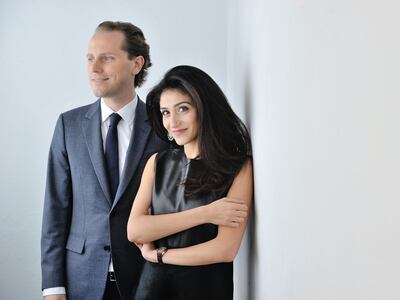
The Business of Fashion
Agenda-setting intelligence, analysis and advice for the global fashion community.

Agenda-setting intelligence, analysis and advice for the global fashion community.

MUNICH, Germany — In a slow luxury jewellery market, expected to grow at a modest 2.1 percent over the next four years according to Euromonitor International, a storied yet relatively under-the-radar fine jewellery company named Hemmerle has attracted fresh attention for its unconventional direct sales strategy, solid results and a level of product that has earned it a reputation as a jeweller's jeweller.
The Munich-based brand — which drove 14.7 percent growth in 2015 according to publicly available filings (the company declined to share financial data) — is wholly owned by the Hemmerle family and has not changed hands since it was founded 125 years ago,
Today, the business is directed by Christian Hemmerle, the 37-year-old great-great-grandson of its founder, together with his wife, Yasmin, and his parents, Stefan and Sylveli. Trading from the same boutique on Munich’s Maximilianstrasse since 1904, the family maintains a slow-paced approach to business. The Hemmerle family eschews standard sales channels, refusing to show in Place Vendôme nor taking part in jewellery fairs such as Couture in Las Vegas or Baselworld; they have no retail partnerships and do not work with sales agents.
A Hemmerle necklace with diamonds, pearls and rock crystal | Source: Courtesy
ADVERTISEMENT
Christian Hemmerle says the business "could have developed at a faster rate, but it was our decision to grow organically and retain our exclusivity. This has made our company stable and we sustained the financial crisis with little impact." The family does not outsource production, keeping all operations in-house. Jewellery business consultant Min Lee tells BoF: "The fact that the Hemmerles haven’t sought external investment nor sold to a large luxury goods group is remarkable."
Hemmerle develops direct sales through constant travel to cities with a high concentration of high net-worth individuals (HNWIs). Forty-five percent of sales are in Munich; the remaining 55 percent of sales are from private viewings and art fairs outside of Germany. The company has been growing its international client base since 1995, when Stefan Hemmerle first exhibited at TEFAF Basel. Today, customers old and new are met by appointment in London, New York and Zurich as well as at Masterpiece and PAD in London, and TEFAF in Maastricht and New York.
Christian Hemmerle sees art fairs as a meeting place for like-minded people. "We believe that one of our key strengths is the direct engagement of our collectors with the family," he says. "We steer away from broader audiences." Lee agrees that the Hemmerles’ relationships with collectors are a chief reason for their success. "They travel to grow their customer base, but are always clear and consistent about who their customer is," she adds. "This is very rare."
Fashion designer Gabriela Hearst started to research Hemmerle after seeing a photo of a piece. She says she became a collector on meeting with the family in New York. Dana Farouki, an advisor to the Guggenheim in the Middle East, began her collection after visiting the Hemmerle workshop in Munich.
Demand at auction for vintage Hemmerle has surged in the last two years, according to Andrés White Correal, senior director of business development, jewellery, at Sotheby’s. "The market has grown more sophisticated, showing increased interest in recognisable-yet-wearable high jewels," he says. "This is exactly what Hemmerle do, with their flawless German engineering, unique sense of colour and entirely own vocabulary."
Hemmerle is to fine jewellery what Goyard is to leather goods.
"Hemmerle is to the fine jewellery industry what Goyard is to the leather goods market," says Winston Chesterfield, custom research director at Wealth-X, a market intelligence consultancy firm focused on high net worth individuals. "A recognisable, covetable product with no e- commerce or retail network means customers come to the brand rather than the other way round."
Prices range from the low thousands to seven-digit figures. "There is no specific price ceiling," Hemmerle says of his decision to dismiss the standard industry pricing structure of demi-fine, fine and high fine jewellery. The brand navigates categories seamlessly, partly because production is restricted.
An average of 220 pieces are made each year, some taking up to 500 hours to complete. The use of unorthodox materials is at the heart of the brand. The first piece that Gabriela Hearst acquired was an olive wood bracelet with rubies set in copper. This was followed by a "twin," as she describes it, crafted from iron with brown diamonds. An emerald was recently set in patinated copper, while aluminium was used for a pair of rhodolite earrings. "We don't use unconventional materials just because they are different," says Hemmerle. "It goes back to the fact that we want to give each gemstone the perfect home."
ADVERTISEMENT

Christian and Yasmin Hemmerle | Source: Courtesy
Sourcing, critical for any fine jewellery business, is at the core of the Hemmerle brand identity. "We travel around the world in search of rare materials such as 18th century cameos or Egyptian miniature mosaics," says Hemmerle. "Finding antique cameos is no easy pursuit and it can take us years to find two for a pair." He admits that finding extraordinary materials, which are increasingly difficult to source, is a significant challenge. Although no two pieces are the same, there are signature styles such as an open-ended bangle with a seamless closure. (One version of this bracelet, in copper, spinels and gold, was acquired for the permanent collection of fine jewellery at London’s Victoria & Albert Museum.)
The Hemmerle workshop is made up of 18 artisans and is unrivalled among European independent fine jewellers. It was originally housed at the back of the Maximilianstrasse store, but has since been moved to a townhouse five minutes’ walk away. Yasmin Hemmerle says the workshop’s proximity to the store allows the family to remain involved in the creation of every piece. "Nothing leaves without approval from the family," she says. Some craftsmen in their ’70s have worked with the Hemmerles for several decades. (One retired artisan came back specifically to carve micro-leaves on copper for a set of clip earrings.)
Apprentices, meanwhile, are a focus of investment for the company as it looks to the future. Staffing, a fundamental consideration for any company whose output depends on skilled artisans, is key to ensure the continuity and transference of know-how — a sine qua non condition for Hemmerle, whose pieces often require techniques that are centuries old. Sourcing is another challenge for the company. Hemmerle’s output requires rare and one-off materials.
"The right combination of luxury and exclusivity shows a business that cares about its audience," says Chesterfield of Wealth-X. "This is compulsory for a smaller company, like Hemmerle, catering to consumers of hard luxury personal goods in the €100,000 to €2 million price range."
However, the seeds of Hemmerle’s success also present challenges to its long-term growth and the question of how the company will expand without damaging its DNA looms large.
Editor's Note: This article was revised on 12 August, 2017. An earlier version of this article included inaccurate estimates of Hemmerle's sales revenue. Hemmerle is a privately-held company and declined to disclose financial data
Related Reading:
[ Jewellery’s Naughty Little Secret: Treated GemstonesOpens in new window ]
[ Is Fine Jewellery Set for a Branding Revolution?Opens in new window ]
[ Can ‘The Leopards’ Become the Oscars of Jewellery?Opens in new window ]
From analysis of the global fashion and beauty industries to career and personal advice, BoF’s founder and CEO, Imran Amed, will be answering your questions on Sunday, February 18, 2024 during London Fashion Week.
The State of Fashion 2024 breaks down the 10 themes that will define the industry in the year ahead.
Imran Amed reviews the most important fashion stories of the year and shares his predictions on what this means for the industry in 2024.
After three days of inspiring talks, guests closed out BoF’s gathering for big thinkers with a black tie gala followed by an intimate performance from Rita Ora — guest starring Billy Porter.